Uncertainty Analysis of Decomposition Level Choice in Wavelet Threshold De-Noising
Abstract
:1. Introduction
2. Uncertainty Analysis in Choosing Decomposition Level
2.1. Complexity of Noises
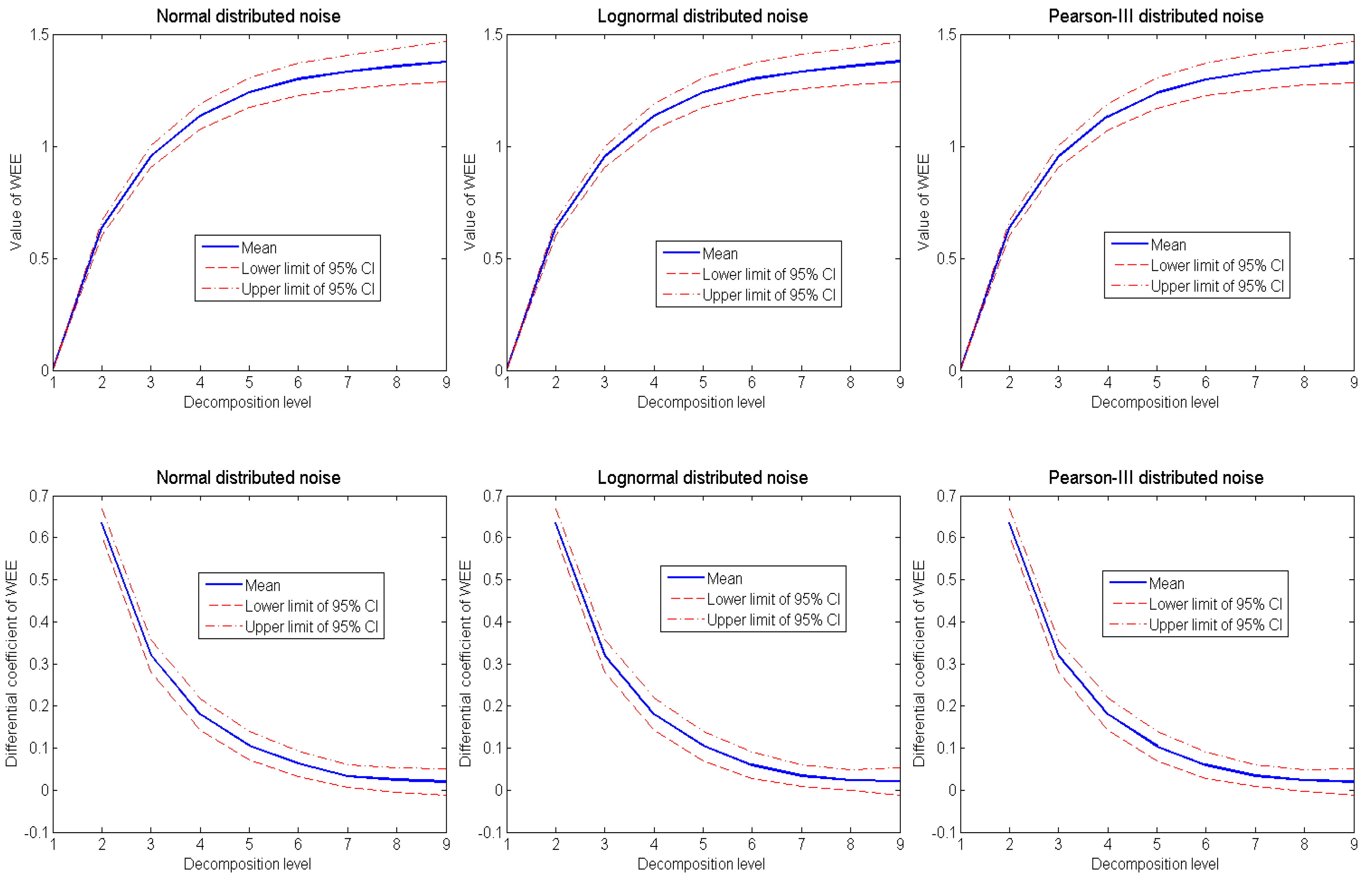
2.2. The Improved Method of Choosing DL
- (1)
- For the noisy series X analyzed, we first calculate the theoretical maximum M of DL by Equation (1), and normalize it by Equation (4):in which and σ(X) are the mean and standard deviation of X, respectively.
- (2)
- Then, we apply dyadic DWT to X by using each value of the DLs from 1 to M, and calculate the values of WEE and D(WEE) by Equation (2) and Equation (3) respectively, based on which we obtain the curves of WEE and D(WEE) of X.
- (3)
- According to the practical situations and experiences, we choose an appropriate probability distribution to generate “normalized” noise with the same length as that of X. Then we determine the curves of WEE and D(WEE) of noise by doing Monte-Carlo test, and also estimate the confidence intervals of them with a proper significance level (e.g., 5%).
- (4)
- Finally, we compare the value of WEE, especially D(WEE), of the noisy series X with those of noise with the increasing of DLs. Once the values of D(WEE) and WEE of X are obviously different from those of noise and exceed the confidence interval under certain DL*, the best DL can be chosen as DL* less 1. Besides, if the values of WEE and D(WEE) of X are close to those of noise under all DLs, the noisy series X can be regarded as a random series.

3. Discussion of the Applicability of the Improved Method
3.1. Synthetic Series Analysis
| Characters | S1 | S2 | S3 | ||||||
|---|---|---|---|---|---|---|---|---|---|
| S11 | S12 | S13 | S21 | S22 | S23 | S31 | S32 | S33 | |
| R1 | 0.666 | 0.326 | 0.083 | 0.714 | 0.212 | 0.062 | 0.681 | 0.234 | 0.051 |
| R2 | 0.663 | 0.343 | 0.067 | 0.710 | 0.216 | 0.025 | 0.671 | 0.260 | 0.006 |
| True SNR | 7.117 | −7.440 | −25.855 | 8.352 | −12.175 | −32.097 | 6.751 | −12.972 | −32.192 |
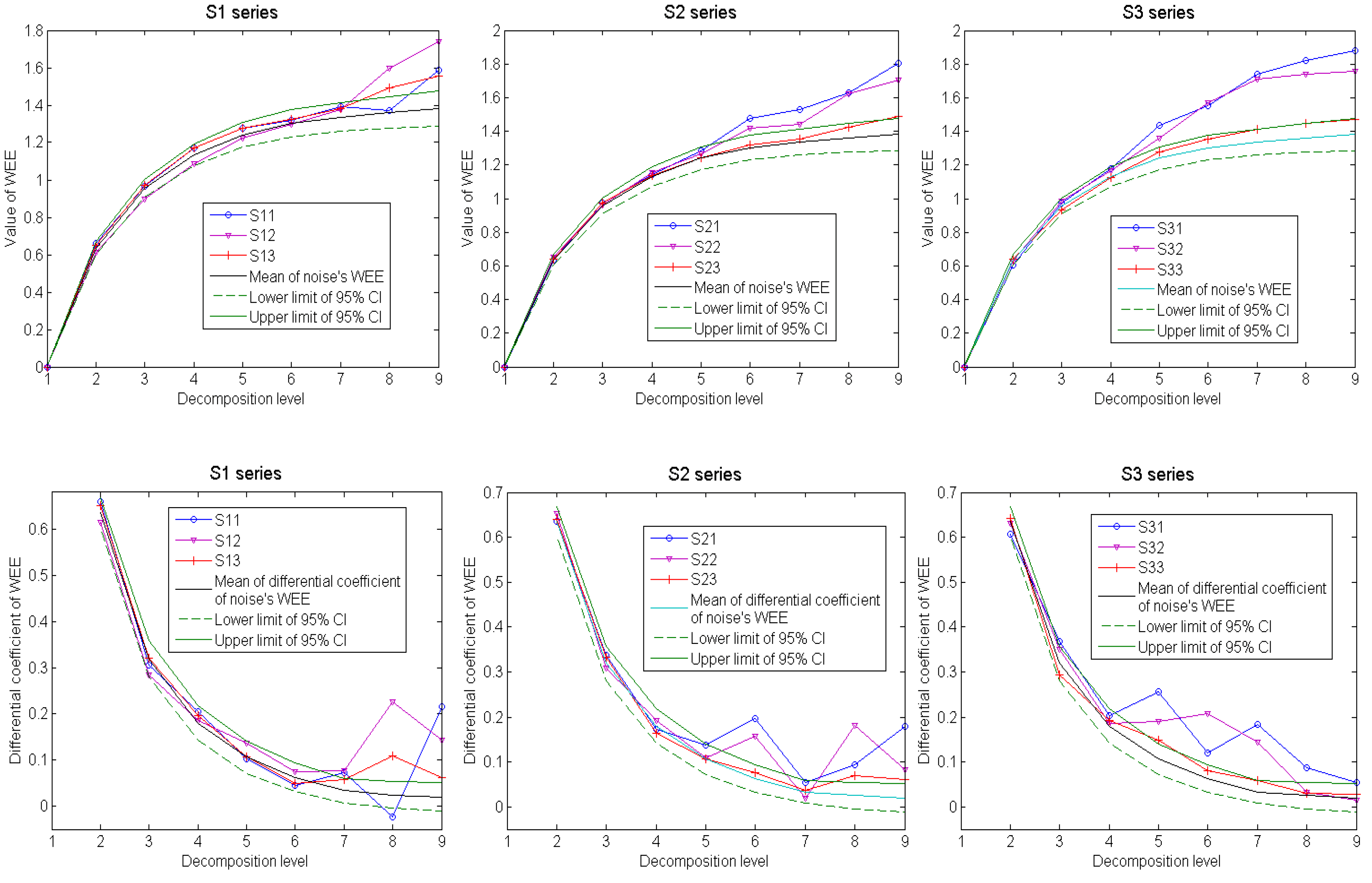
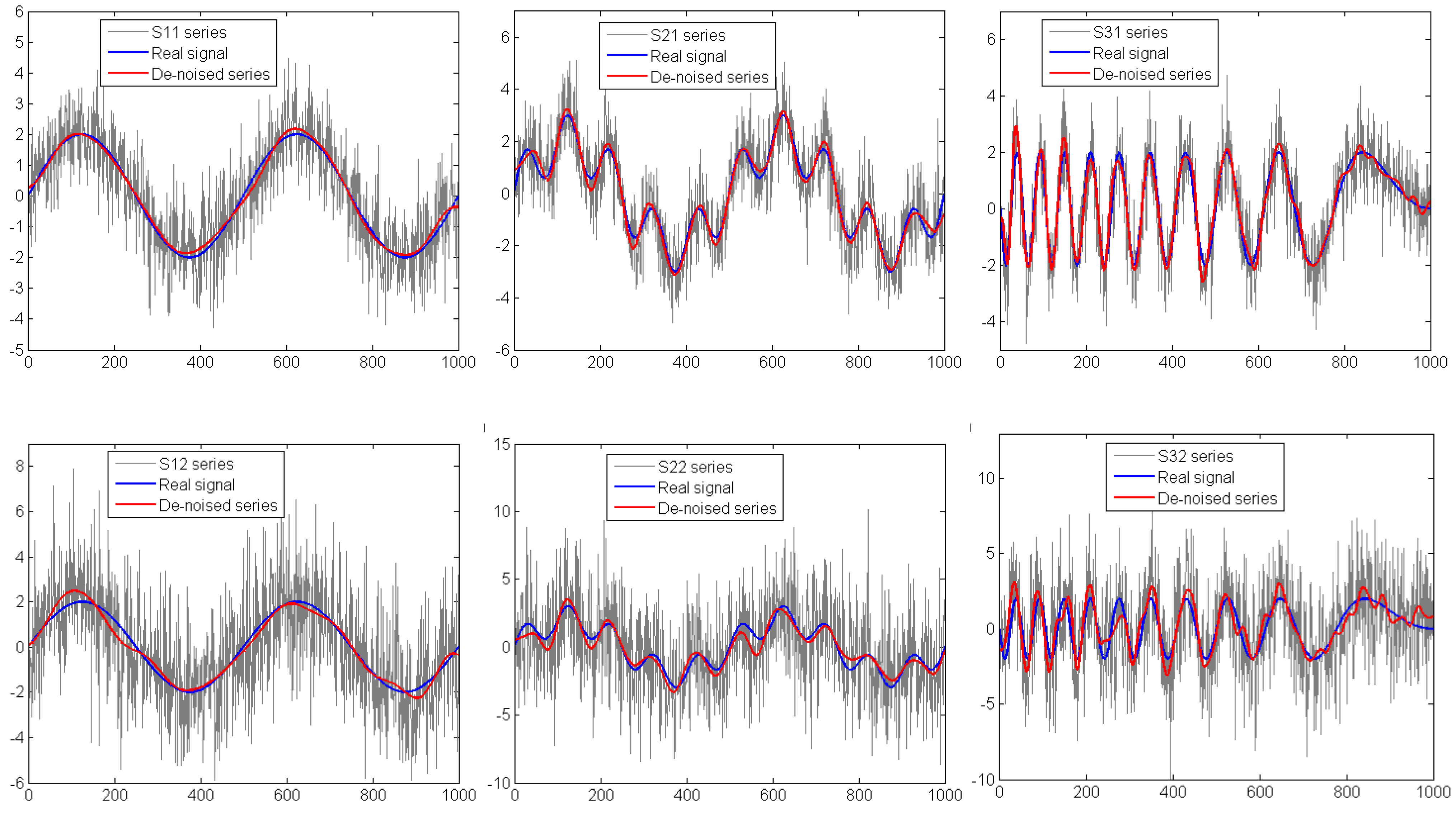
3.2. Observed Series Analysis
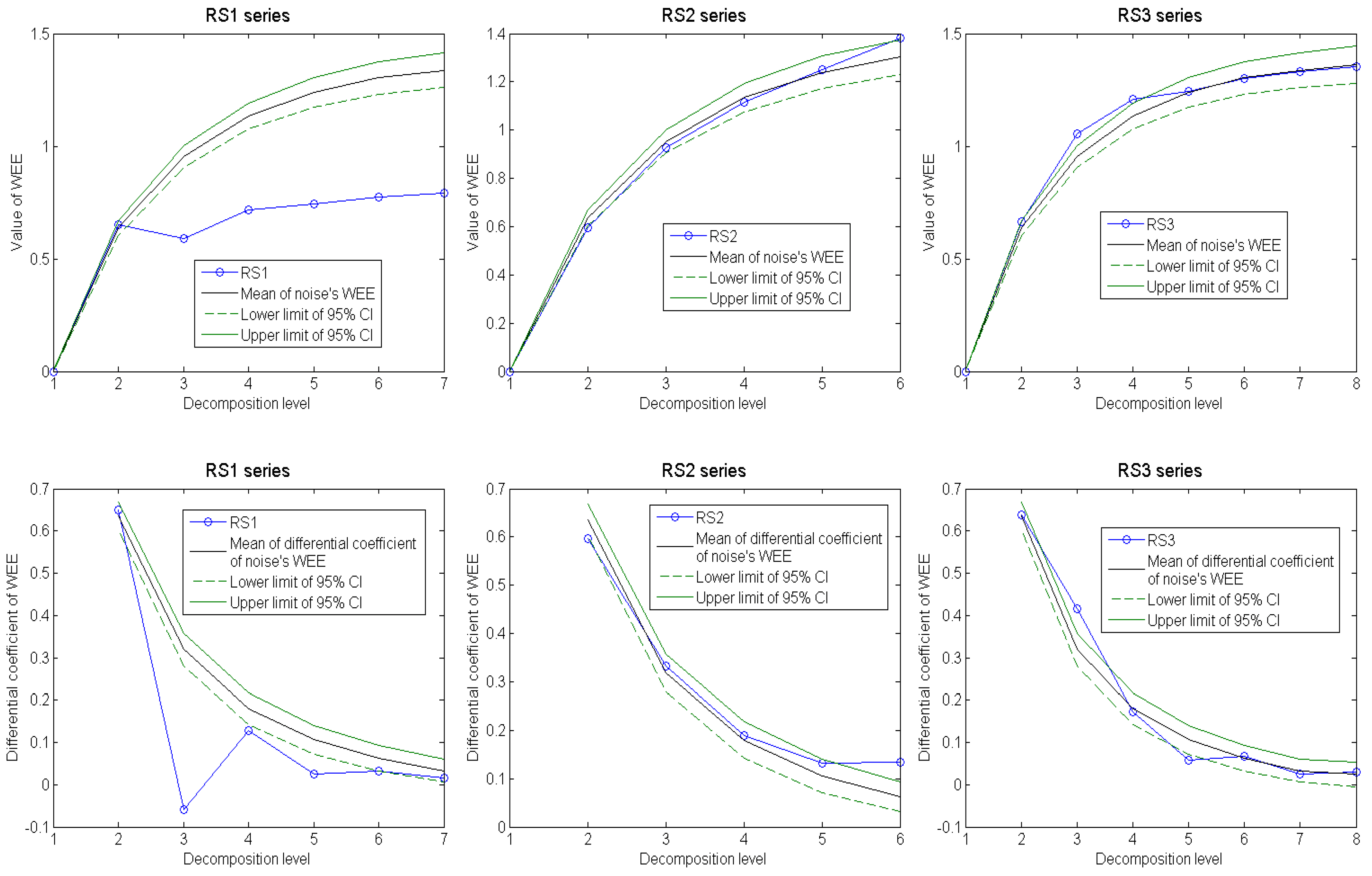
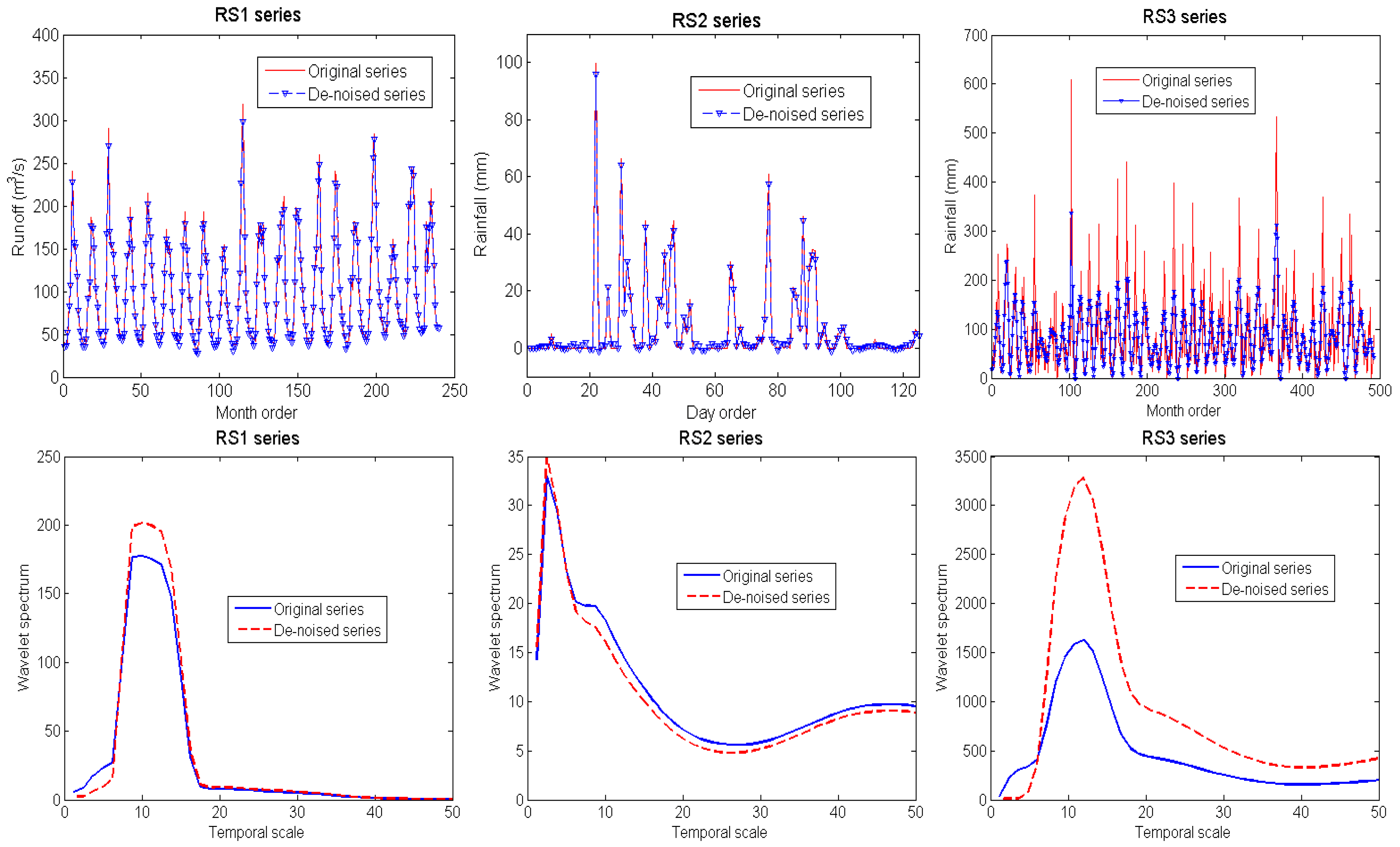
4. Conclusions
Acknowledgements
References
- Alexander, M.E.; Baumgartner, R.; Summers, A.R.; Windischberger, C.; Klarhoefer, M.; Moser, E.; Somorjai, R.L. A wavelet-based method for improving signal-to-noise ratio and contrast in MR images. Magn. Reson. Imag. 2000, 18, 169–180. [Google Scholar] [CrossRef]
- Hrachowitz, M.; Soulsby, C.; Tetzlaff, D.; Dawson, J.J.C.; Dunn, S.M.; Malcolm, I.A. Using long-term data sets to understand transit times in contrasting headwater catchments. J. Hydrol. 2009, 367, 237–248. [Google Scholar] [CrossRef]
- Sang, Y.F.; Wang, D.; Wu, J.C.; Zhu, Q.P.; Wang, L. The relation between periods’ identification and noises in hydrologic series data. J. Hydrol. 2009, 368, 165–177. [Google Scholar] [CrossRef]
- Wang, D.; Singh, V.P.; Zhu, Y.S.; Wu, J.C. Stochastic observation error and uncertainty in water quality evaluation. Adv. Water Resour. 2009, 32, 1526–1534. [Google Scholar] [CrossRef]
- Khan, T.; Ramuhalli, P.; Zhang, W.G.; Raveendra, S.T. De-noising and regularization in generalized NAH for turbomachinery acoustic noise source reconstruction. Noise Contr. Eng. J. 2010, 58, 93–103. [Google Scholar] [CrossRef]
- Torrence, C.; Compo, G.P. A practical guide to wavelet analysis. Bull. Amer. Meteorol. Soc. 1998, 79, 61–78. [Google Scholar] [CrossRef]
- Percival, D.B.; Walden, A.T. Wavelet Methods for Time Series Analysis; Cambridge University Press: Cambridge, UK, 2000. [Google Scholar]
- Labat, D. Recent advances in wavelet analyses: Part 1. A review of concepts. J. Hydrol. 2005, 314, 275–288. [Google Scholar] [CrossRef]
- Donoho, D.H. De-noising by soft-thresholding. IEEE Trans. Inform. Theor. 1995, 41, 613–617. [Google Scholar] [CrossRef]
- Natarajan, B.K. Filtering random noise from deterministic signals via data compression. IEEE Trans. Signal Process. 1995, 43, 2595–2605. [Google Scholar] [CrossRef]
- Kazama, M.; Tohyama, M. Estimation of speech components by AFC analysis in a noisy environment. J. Sound Vib. 2001, 241, 41–52. [Google Scholar] [CrossRef]
- Elshorbagy, A.; Simonovic, S.P.; Panu, U.S. Noise reduction in chaotic hydrologic time series: Facts and doubts. J. Hydrol. 2002, 256, 147–165. [Google Scholar] [CrossRef]
- Sang, Y.F.; Wang, D.; Wu, J.C.; Zhu, Q.P.; Wang, L. Entropy-based wavelet de-noising method for time series analysis. Entropy 2009, 11, 1123–1147. [Google Scholar] [CrossRef]
- Coifman, R.; Wickerhauster, M.V. Entropy based algorithms for best basis selection. IEEE Trans. Inform. Theor. 1992, 38, 713–718. [Google Scholar] [CrossRef]
- Berger, J.; Coifman, R.D.; Goldberg, M.J. Removing noise from music using local trigonometric bases and wavelet packets. J. Audio Eng. Soc. 1994, 42, 808–818. [Google Scholar]
- Schaefli, B.; Maraun, D.; Holschneider, M. What drives high flow events in the Swiss Alps? Recent developments in wavelet spectral analysis and their application to hydrology. Adv. Water Resour. 2007, 30, 2511–2525. [Google Scholar] [CrossRef]
- Jansen, M.; Bultheel, A. Asymptotic behavior of the minimum mean squared error threshold for noisy wavelet coefficients of piecewise smooth signals. IEEE Trans. Signal Process. 2001, 49, 1113–1118. [Google Scholar] [CrossRef]
- Jansen, M. Minimum risk thresholds for data with heavy noise. IEEE Signal Process. Lett. 2006, 13, 296–299. [Google Scholar] [CrossRef]
- Dimoulas, C.; Kalliris, G.; Papanikolaou, G.; Kalampakas, A. Novel wavelet domain Wiener filtering de-noising techniques: application to bowel sounds captured by means of abdominal surface vibrations. Biomed. Signal Process. Contr. 2006, 1, 177–218. [Google Scholar] [CrossRef]
- Bruni, V.; Vitulano, D. Wavelet-based signal de-noising via simple singularities approximation. Signal Process. 2006, 86, 859–876. [Google Scholar] [CrossRef]
- Chanerley, A.A.; Alexander, N.A. Correcting data from an unknown accelerometer using recursive least squares and wavelet de-noising. Comput. Struct. 2007, 85, 1679–1692. [Google Scholar] [CrossRef]
- Box, G.E.P.; Jenkins, G.M.; Reinsel, G.C. Time Series Analysis, Forecasting and Control; Prentice-Hall: Saddle River, NJ, USA, 1994. [Google Scholar]
- Sang, Y.F.; Wang, D.; Wu, J.C. Entropy-based method of choosing the decomposition level in wavelet threshold de-noising. Entropy 2010, 6, 1499–1513. [Google Scholar] [CrossRef]
- Chui, C.K. An Introduction to Wavelets; Academic Press: Boston, MA, USA, 1992; Volume 1. [Google Scholar]
- Jaynes, E.T. Information theory and statistical mechanics. Phys. Rev. 1957, 106, 620–630. [Google Scholar] [CrossRef]
© 2010 by the authors; licensee MDPI, Basel, Switzerland. This article is an open access article distributed under the terms and conditions of the Creative Commons Attribution license (http://creativecommons.org/licenses/by/3.0/).
Share and Cite
Sang, Y.-F.; Wang, D.; Wu, J.-C. Uncertainty Analysis of Decomposition Level Choice in Wavelet Threshold De-Noising. Entropy 2010, 12, 2386-2396. https://doi.org/10.3390/e12122386
Sang Y-F, Wang D, Wu J-C. Uncertainty Analysis of Decomposition Level Choice in Wavelet Threshold De-Noising. Entropy. 2010; 12(12):2386-2396. https://doi.org/10.3390/e12122386
Chicago/Turabian StyleSang, Yan-Fang, Dong Wang, and Ji-Chun Wu. 2010. "Uncertainty Analysis of Decomposition Level Choice in Wavelet Threshold De-Noising" Entropy 12, no. 12: 2386-2396. https://doi.org/10.3390/e12122386






